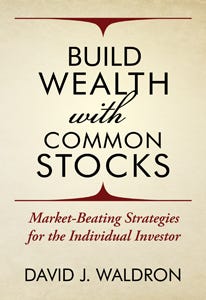Elements of Quality Value Investing | Part Four of a Series
The best of the QVI newsletter series on how the quality-driven value investing strategy prevails for those seeking to outperform their market benchmark
Welcome to Quality Value Investing (QVI), where the QVI Stock Picks have generated alpha since 2008. To preview the newsletter posts and research reports, become a free subscriber. Upgrade to a paid subscription to access the full text and audio of the newsletter and the QVI Stock Picks Real-Time Performance Tracker.
Audio voiceover:
Substack’s AI-generated voiceover is now available on Quality Value Investing. To access it, open the post in the Substack app. Please share your thoughts on the audio in the comments or through direct message. I will use AI to clone my voice for future QVI posts.
Learn more about audio voiceovers:
https://davidjwaldron.substack.com/p/audio
In this fourth and final installment of a series, we’ll explore further the principles, strategies, and practices that make up the checklist of metrics and behaviors used to select primary tickers for Quality Value Investing’s (QVI) alpha-generating Real-Time Stock Picks.
The QVI newsletter narrative posts highlight the key elements and reliable indicators for identifying high-quality companies whose stocks are temporarily trading at fair or discounted prices.
By focusing on a company’s current wealth and a stock price’s present value, QVI’s 42 active picks have collectively outperformed the S&P 500 index by 10,301 basis points (bps) or 103.01 percentage points, based on the average per holding since inception, using an equal-weighted approach.1
The seven current holdings of the QVI Stock Picks in our family’s concentrated portfolio have collectively outperformed the market by 43,936 basis points or 439.36 percentage points, based on the average per holding since inception, using the same equal-weighted approach.
The goal of this post is to examine best practices for building a self-managed portfolio of high-quality stocks purchased at reasonable prices through dividend value investing, mastering the art of behavioral investing, understanding why most investors underperform their market benchmark, and how achieving alpha is a challenging pursuit.
Concentrate on Dividend Value Investing
Dividend value investing is a term I introduced in my book, Build Wealth with Common Stocks. It highlights a company’s quality and stock’s value more than its dividend growth history.
In other words, any dividends are a bonus in the short term, while waiting for capital gains to increase over the long term.
Here’s a list of soundbites that define and promote dividend value investing, emphasizing the preservation of invested capital, in contrast to the more popular but riskier dividend growth and forward high-yield strategies.
The principles of dividend value investing emphasize quality at a fair price.
Chasing high dividend yields is a recipe for junk equity.
Yield-on-cost — the dividend recognized based on current rate of return on the average share purchase price provides a profitable alternative to the forward high-yield dividend approach.
Remember that a lower dividend payout ratio is more favorable.
Thoughtful value investors allocate dividends in their portfolios for short-term compensation while waiting for long-term capital appreciation.
Build and maintain portfolio wealth through dividend value investing.
Master the Art of Behavioral Investing
Behavioral investing emphasizes the use of rational thinking, discipline, and patience in managing personal portfolios.
Many investors are unaware of the mental traps that can harm both self-directed and professionally managed portfolios. Mastering behavioral investing helps close the growing gap between psychology and finance.
Rational Thought
Successful retail investors are rational about continually improving their investment knowledge.
Here’s how to profitably apply rational thinking to a disciplined and patient investing strategy to counter the apparent lack of it in the financial markets.
Use common sense in retail investing.
Relying on deep dive predictive analysis is a fool’s game. Stick to the facts such as the company’s current wealth and the stock price’s present value.
Prioritize emotional intelligence (EQ) over raw emotions and IQ alone.
Accept that physical and mental health are more important than financial wealth.
Discipline
Successful retail investors are disciplined in conducting thorough research to identify high-quality, publicly traded companies with stock prices that offer wide margins of safety.
Here’s how to effectively incorporate discipline into a patient and rational investing approach to address the apparent absence of discipline in the financial markets.
Learn about and understand the business.
Commit to quality and valuation.
Understand and accept the potential risks associated with stock investing.
Be willing to make difficult decisions and take accountability.
If possible, avoid losing money by selling a position at a loss below its cost basis.
Patience
Successful retail investors are patient while waiting for capital gains and dividend growth over time.
Here’s how to effectively utilize patience within a disciplined and rational investment strategy, countering the evident lack of patience in the financial markets.
Patient investing tends to be the most profitable.
Practice and master patient investing, as it is one of the rarest and therefore most valuable commodities on Wall Street and Main Street.
Patience is the most beneficial tool for a quality value investor.
Why Most Investors Fail to Beat the Market
Most investors, whether retail or professional, tend to underperform the market over time. As a result, they continue to seek new investment strategies and stock-picking ideas for a simple reason: their current methods of managing portfolios don't generate alpha.
Forgive the cynical approach; however, sometimes flipping the coin and examining the negative aspects of an applied discipline, such as stock market investing, can be just as impactful as discovering the positive qualities of selecting winning stocks from enduring companies.
Let’s closely examine investment practices and schemes in the stock market that hinder alpha rather than generate it. We’ll address each type of self-sabotaging investing behavior with suggested solutions.
It appears that most investors aim to accumulate wealth rapidly. However, successful investors tend to grow rich gradually.
Investors sabotage their portfolios by getting caught up in the noise on Wall Street. Filter the bluster by remaining focused on quality and value.
Many retail investors lack rational thinking, discipline, or patience. Remember that investing is half numbers crunching and half productive behaviors.
It seems that most investors foolishly buy out of greed and sell out of fear. The opposite approach is most effective over a long-term investment horizon.
The passive investing crowd reminds us that indexing also decreases in value as far as the market does. To achieve alpha, invest in the top-performing stocks of high-quality companies and limit index exposure to hedge against those stocks.
They prioritize high yields over the more lucrative strategy of gaining total returns from capital appreciation and dividend income.
They overlook a consequential market truth: Price is what we pay in the short term, and value is what we get over time. Stick to quality bought at a reasonable price.
They rely on unproductive emotions instead of principled strategies. Remember that alpha-achieving investments require cognitive efforts, not emotional reactions.
Achieving Alpha is a Lonely Pursuit
American investor Shelby Cullom Davis (1909-1994) invested his wife’s $100K inheritance using quality-driven value investing and grew the portfolio to over $900 million during his lifetime.
After Shelby retired, his son took over managing the portfolio and noticed that his father published a regular newsletter sharing his investment strategies with the public.
Interestingly, there were few subscribers. When the son asked about the lack of public interest in his father's secrets to building wealth, Shelby explained he was an introvert who made money slowly. Throughout his career, he learned that the public was more inclined to follow extroverts who promised quick returns.
Nevertheless, he adhered to his portfolio-building principles, strategies, and practices, never giving in to the investment newsletter-reading crowd’s desire for quick profits.
The lesson from Shelby Davis’s story in contradiction is that most financial advisors and newsletter editors underperform the market. However, many earn millions in advisory or subscription fees. They generate “alpha” by selling a dream instead of consistently growing invested capital and reinvesting dividend income better than Mr. Market.
Whether you use a money manager, newsletter editor, self-direct, or combine these approaches, portfolio results are key when investing. Remember, aside from fees, Wall Street and the crowd it serves are almost always wrong over the long term.
Like Shelby Davis, study and work to become your portfolio’s independent investing expert.
This series recaps the best practices of Quality Value Investing, as learned, practiced, and shared with QVI’s subscribers. Here are links to the first three parts, in case you missed any of them.
Resources
QVI’s Research Reports Archive and Stock Picks Real-Time Performance Tracker provide the latest analysis and performance data for the 42 active QVI Stock Picks, including the series’s proprietary research checklist.
The real-time final draft manuscript of my upcoming fifth book, Quality Value Investing: How to Pick the Winning Stocks of Enduring Enterprises, is now available on my author's website, hosted on Substack.
Read or Listen to the Real-Time Manuscript
About the Writer
David J. Waldron is the contributing editor of Quality Value Investing and the author of the international-selling book Build Wealth with Common Stocks: Market-Beating Strategies for the Individual Investor, as well as his upcoming fifth book, Quality Value Investing: How to Pick the Winning Stocks of Enduring Enterprises.
He is a private investor and a former expert advisor to hedge funds, mutual funds, private equity firms, and investment banks.
David’s mission is to inspire his readers to reach their financial goals and dreams. His work has been featured in Substack Finance, Substack Business, Seeking Alpha, MSN Money, TalkMarkets, ValueWalk, Yahoo Finance, QAV—Australia’s #1 Value Investing Podcast, Money Life with Chuck Jaffe, LifeBlood with George Grombacher, The Acquirer’s Multiple, Capital Employed, and on platforms like Amazon, Barnes & Noble, Apple Books, The BookLife Prize, and Publisher’s Weekly.
David enjoyed a 25-year career as an executive in postsecondary education services. He earned a Bachelor of Science in Business Studies as a Garden State Scholar at Stockton University and completed The Practice of Management Program at Brown University. Learn more at davidjwaldron.substack.com.
“Investing advice is fairly commonplace, but here the author shares his own unique investment wisdom that readers will not find elsewhere.” —Critic’s Report, The BookLife Prize (Publishers Weekly)
Lifetime Founding subscribers can receive a free author-personalized jacketed case laminated hardcover edition of David’s fourth book.
Founding subscribers supporting QVI on Substack Finance also receive a complimentary permanent subscription renewal for the service’s lifetime. After the first paid year, no renewal is necessary. Please consider upgrading today.
If the button is not functional on your mobile device, enter this URL in your desktop or laptop browser and go to the Lifetime Founder column:
davidjwaldron.substack.com/subscribe
Or you can preview or purchase the book at your favorite online bookstore worldwide using our convenient universal link:
Earn Premium upgrade rewards when you refer members of your network, including family, friends, or colleagues, to the Quality Value Investing newsletter on Substack.
Disclosure: As of this post, our family’s concentrated portfolio held beneficial long positions in the common shares of seven companies listed in the QVI Real-Time Stock Picks. I authored this report, sharing my opinions without any compensation beyond the paid subscriptions on Substack or the royalties from the sales of my published books. I have no business relationships with any of the companies represented in the QVI Stock Picks.
Additional Disclosure: David J Waldron’s Quality Value Investing newsletter posts are for informational purposes only. Data accuracy is not guaranteed. Narratives and analytics are impersonal and not tailored to individual needs or portfolio construction beyond the QVI Stock Picks, presented solely for educational purposes. David is a private investor and author, not an investment adviser. Readers should conduct independent research or due diligence and consider consulting a fee-only financial planner, a licensed discount broker, a flat-fee registered adviser, a certified public accountant, or a specialized attorney before making investment, tax, or estate planning decisions.
Disclaimer: Although Quality Value Investing takes a skeptical view of the financial services industry, commonly referred to in the media as Wall Street—a euphemism for professional or institutional investing globally—it does not imply nor express specific issues or negative references regarding any actual organizations or individuals working within the financial sector. Any perceived connection or offense to actual firms or individuals is coincidental and unintentional. In its general critique of the universal Wall Street business model, QVI avoids unproven conspiracy theories and offers a platform for commentary, critique, education, and parody. In this context, facts stand apart from any alternative perspectives. Therefore, the subjective thoughts shared by the author throughout the post are his opinions and should not be construed as factual.
Source: Quality Value Investing via Google Finance. Combined stock picks’ cumulative performance data as of the market close on July 21, 2025. Past performance is not indicative of future results. Please read the essential disclosures listed above.














